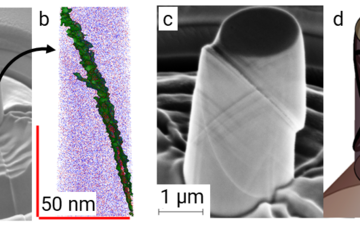All genres
61.
Journal Article
Oxygen electrochemistry as a cornerstone for sustainable energy conversion. Angewandte Chemie International Edition 53 (1), pp. 102 - 121 (2014)
62.
Journal Article
Die Elektrochemie des Sauerstoffs als Meilenstein für eine nachhaltige Energieumwandlung. Angewandte Chemie 126 (1), pp. 104 - 124 (2014)
63.
Journal Article
A comparative study on gold and platinum dissolution in acidic and alkaline media. Journal of the Electrochemical Society 161 (12), pp. H822 - H830 (2014)
64.
Journal Article
Effect of temperature on gold dissolution in acidic media. Journal of the Electrochemical Society 161 (9), pp. H501 - H507 (2014)
65.
Journal Article
Towards a comprehensive understanding of platinum dissolution in acidic media. Chemical Science 5 (2), pp. 631 - 638 (2013)
66.
Journal Article
Gold dissolution: Towards understanding of noble metal corrosion. RSC Advances 3 (37), pp. 16516 - 16527 (2013)
67.
Journal Article
Effect of thiol self-assembled monolayers and plasma polymer films on dealloying of Cu–Au alloys. RSC Advances 3 (18), pp. 6586 - 6595 (2013)
68.
Journal Article
Electrochemical dissolution of gold in acidic medium. Electrochemistry Communucations 28, pp. 44 - 46 (2013)
69.
Journal Article
The influence of halides on the initial selective dissolution of Cu3Au (111). Electrochimica Acta 85, pp. 384 - 392 (2012)
70.
Journal Article
Dissolution of Platinum: Limits for the Deployment of Electrochemical Energy Conversion? Angewandte Chemie, International Edition 51 (50), pp. 12613 - 12615 (2012)
71.
Journal Article
Die Auflösung von Platin – Grenzen für den Einsatz zur elektrochemischen Energieumwandlung? Angewandte Chemie 124 (50), pp. 12782 - 12785 (2012)
72.
Meeting Abstract
Stability of binary metallic ceramics in the HER reaction - feasible HER electrocatalysts in acidic medium? In Abstracts of Papers of the American Chemical Society, 254, 350. 254th National Meeting and Exposition of the American-Chemical-Society
(ACS) on Chemistry's Impact on the Global Economy, Washington, DC, August 20, 2017 - August 24, 2017. (2017)
73.
Talk
Operando study on the activation and corrosion of (photo)electrocatalysts. Colloquium, Ludwig-Maximilians-Universität
, München, Germany (2022)
74.
Talk
Correlating Atomic Scale Structure with Reaction Mechanisms: Electrocatalytic Evolution of Oxygen. 70th Annual Meeting of the International Society of Electrochemistry, Durban, South Africa (2019)
75.
Talk
Photocatalytic water splitting and photocorrosion of BiVO4. International Workshop Microscale Motion and Light, Dresden, Germany (2019)
76.
Talk
Electrochemical CO2 Reduction: A Combinatorial High-Throughput Approach for Catalytic Activity, Stability and Selectivity Investigations. International Conference on Combinatorial Materials Research, Ghent, Belgium (2015)
77.
Talk
Platinum electrochemial dissolution and its consequences for platinum electrocatalysis. 227th ECS Meeting, Chicago, IL, USA (2015)
78.
Talk
Combinatorial study of fundamental electrocatalyst performance - The scanning flow cell coupled to online analytics. 227th ECS Meeting, Chicago, IL, USA (2015)
79.
Talk
Perspectives for design of active and stable oxygen evolution electrocatalysts. 227th ECS Meeting , Chicago, IL, USA (2015)
80.
Talk
Fast screening of electrocatalyst activity and stability utilizing combinatorial coupled techniques. Hydrogen Technologies Conference 2014, Taormina, Italy (2014)











